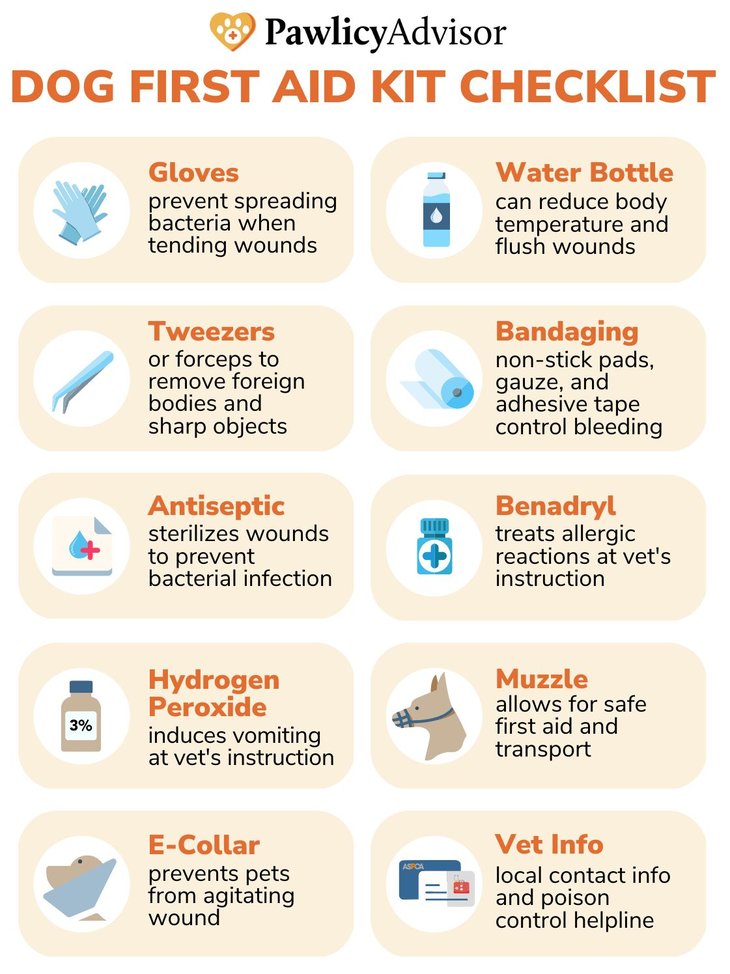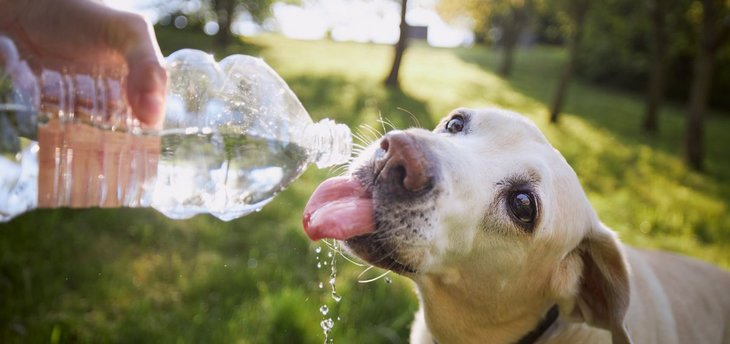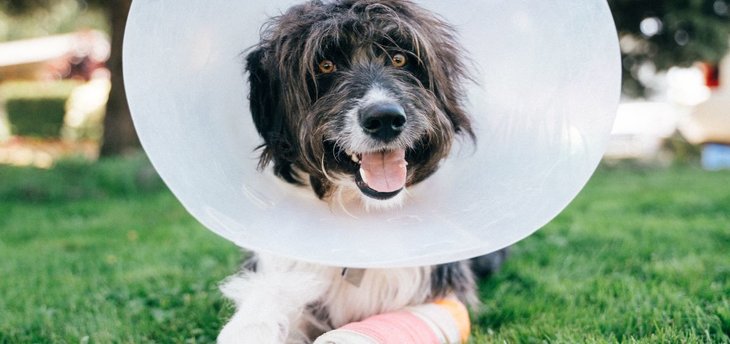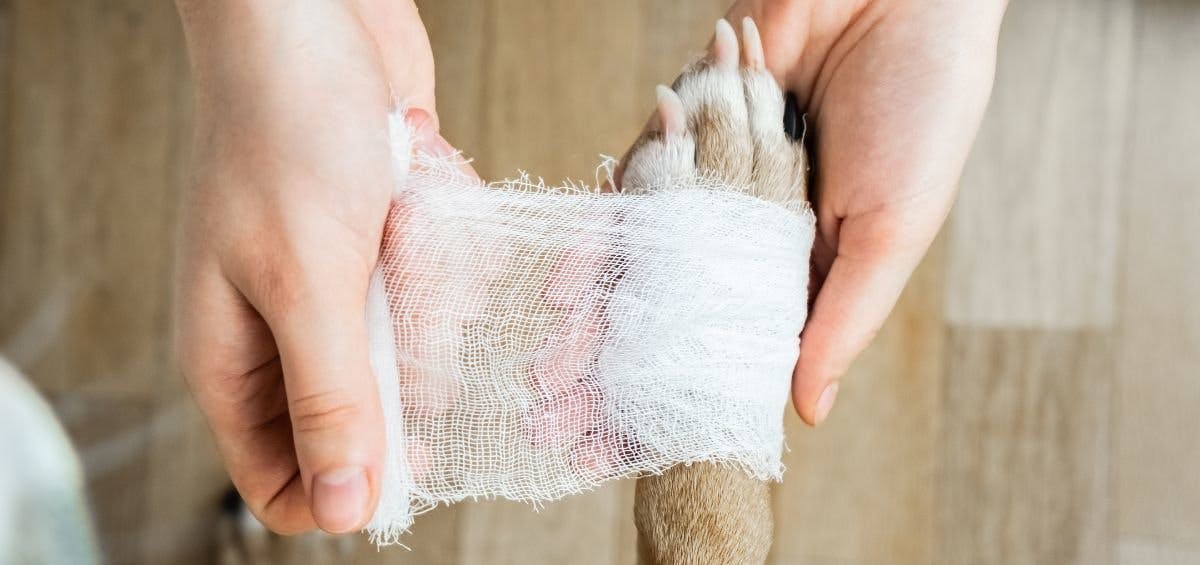Top 10 Items To Put In A First Aid Kit For A Dog
As a pet parent, you should always be prepared for injuries that your dog can incur at home or on the go — but what do you need in a first aid kit for a dog? What situations should you be prepared for?
Some people can predict the future.For everyone else, there's pet insurance.
In this article, we cover the top 10 essentials every dog owner needs in a pet first aid kit, along with how to respond to common situations in which your pet requires prompt medical attention.
Table of Contents:
The Importance of First Aid For Dogs
Most pet owners can't imagine anything ever happening to their beloved fur child, but no matter how hard you try to protect them, accidents are always a possibility. In the United States, it's estimated that a dog will receive emergency vet care every 2.5 seconds — you never know if or when that dog might be yours.1
1 dog every 2.5 seconds
will need emergency care
During medical emergencies, every second counts, so it's important to act expediently by knowing the risks and planning how to respond to them ahead of time.
Understanding Common Dangers to Dogs
While unexpected visits to the animal hospital can come as a surprise, there are several risk factors that may increase your likelihood of needing a dog first aid kit one day.
Breed-specific traits
Some of the most popular dog breeds are prone to experiencing injuries that often call for pet first aid, such as:
- French Bulldogs (and all brachycephalic or "flat-faced" breeds such as Pugs, English Bulldogs, and Boxers) have difficulty regulating their body temperatures and are, therefore, more likely to experience heat stroke due to sun exposure and more quickly than other breeds. If you notice signs of heat stroke in your dog, apply water to the paws and ears to help cool your dog down while seeking immediate veterinary assistance.
- German Shepherds, Labrador Retrievers, and Golden Retrievers often present limping of an unknowing origin, frequently attributable to a soft tissue tear. If you notice your dog display lameness after a vigorous run or play session, it's wise to restrict his or her activity to prevent the problem from worsening until the injury is identified.
- Poodles are prone to skin lacerations while being groomed — especially when inexperienced pet parents provide DIY haircuts at home. Apply pressure to the cut with gauze or a clean towel to control bleeding, and consult your vet to see if stitches are necessary.
- Huskies are notorious escape artists and often express their need for exercise by running out the door, which unfortunately leads to increased involvement in car accidents. If your dog is hit by a car, be sure to control any bleeding on the way to the vet.
Environmental safety hazards
Certain places or activities can create a greater risk of injury and, therefore, may be likelier to require first aid for dogs. Here are a few examples:
- Dog parks present a higher chance of your pet getting into an altercation that may result in a laceration or puncture wound.
- Hikes offer great exercise for both you and your pup but introduce a number of risks, such as high falls, snake bites, burnt paw pads, and heat stroke.
- Beaches are great places for dogs to play, dig, and swim, but they often come with numerous safety risks, including ingested fish hooks, broken glass, sunburn, and dehydration.
What to Put in a Dog First Aid Kit
Below are 10 dog first aid essentials that you should make sure you have within short reach, especially if your pet is susceptible to an injury.

Download the dog first aid checklist in PDF format here.
1) Gloves
When emergency pet first aid is required, you might not have the opportunity to wash your hands before treating your dog’s wound — especially for accidents that occur outdoors, such as at the beach, on a hike, or in a dog park. A pair of disposable latex gloves can help prevent you from introducing additional dirt or bacteria into an open wound while you are cleaning and bandaging it, thereby minimizing the chance of infection.
Gloves can also prevent bacteria or other organisms on your dog's fur from entering any open cuts or wounds on your hands. While it is rare to contract a disease from contact with your dog's blood, maintaining good hygiene is still important.
2) Water bottle
Keeping an unopened water bottle in a dog first aid kit can help in multiple situations. First, if you are worried your pet is overheating, you can offer him or her small amounts of water to drink. If your dog experiences heat stroke due to excessive sun exposure, then wetting their paws and ears with water can significantly help lower their body temperature while getting them to the vet.
If you don’t have a sterile saline solution in your dog first aid kit to use as a wound wash, then clean, filtered water can also be used to wash dirty wounds before applying a bandage. Pour the water bottle over the open skin to flush large pieces of dirt, debris, or mud from the area.

3) Tweezers
While forceps or hemostats are the preferred tools to remove foreign bodies, they’re less common to have on hand around the house, so you’ll be more likely to add tweezers to your dog first aid kit. Tweezers can work well when cleaning treating wounds because they can grasp objects embedded in dogs’ skin, paws, or ears, like broken glass or sticky burs — but proceed with caution.
Some objects, such as fishing hooks that dogs are known to swallow, have barbed ends and may cause more damage if they are removed improperly through the skin. Others, like foxtails, can be very difficult to see, which makes them tricky to remove entirely. In some cases, the embedded object could be slowing down bleeding or temporarily sealing a major wound, making it better to leave in place until your dog can be seen by a vet.
Additionally, removing multiple foreign bodies at once, such as porcupine quils, can be very painful without sedation and is not recommended. All foreign bodies can cause a great deal of discomfort for your pet, though, which may cause even the sweetest dog to bite or nip when attempting to administer first aid.
4) Antiseptic solution
Prior to dressing a dog’s wound, it’s imporant to sterilize the area with an antiseptic solution to prevent bacterial infection. Betadine is a popular choice among many vets, but whatever wound wash you use should be sterile and safe for your dog to lick.
5) Bandaging materials
In the event your pet has an open, bleeding wound, applying pressure with a bandage is important to stop or slow bleeding. If you don’t have bandage material available, a clean towel or T-shirt can also work well.
To apply a bandage, start by placing the non-adhesive pad over the wound to prevent other bandage material from sticking to fresh blood and causing pain or disrupting a blood clot when it is removed. The gauze roll can be used to apply pressure to the wound over the pad. It’s one of the most important items in a cat or dog first aid kit because the material is lightweight, absorbent, and can be especially helpful for wounds on paws or legs.
No matter where the bandage is located, you can cover it with adhesive tape to hold it in place and protect the bandage from moisture. Remember that bandages can cause harm if they are placed too tight or left on for too long, so even if the bleeding stops after bandaging, you should still have your pet seen by a veterinarian urgently.

6) Hydrogen peroxide
If your pet has ingested dangerous food for dogs (i.e., chocolate, anti-freeze, human medication) or an item that has a high chance of causing an obstruction (i.e., a toy or piece of clothing), your vet might recommend that you induce vomiting.
Never try to induce vomiting in your pet without first consulting a veterinarian or pet poison control. Some items can cause harm to the esophagus if your pet vomits them back up. Additionally, there is a risk of your pet inhaling some of the fluid they bring up, which can lead to aspiration pneumonia.
It is always safest to take your pet to a veterinary office so that the staff can induce vomiting with medications specifically approved for dogs. Hydrogen peroxide has been shown to cause ulceration in the gastrointestinal tract of dogs when it is used to induce vomiting. Therefore, it should only be used under explicit instruction from a veterinarian in cases of extreme emergencies.
7) Benadryl
Diphenhydramine, including the generic brand Benadryl®, is an antihistamine that can help reduce facial swelling in dogs due to allergic reactions — especially to insect bites and bee stings.
While facial swelling caused by mild anaphylaxis may be alarming in appearance, it’s rarely life-threatening. Signs of more severe allergic reactions include trouble breathing, collapse, rapid bruising, or a change in gum color. Anaphylactic shock can be fatal, so call your vet immediately.
While Benadryl for dogs is generally safe, you should ask your vet for an appropriate dosage specific to your pet and make sure that the medication will not interact with other drugs or supplements they may be taking.
Keep in mind that there are many types of Benadryl on the market, so be sure your product is pet-safe by confirming the only active ingredient is diphenhydramine. Also, check the ingredient label to verify it does not include xylitol, an artificial sweetener that is highly toxic to dogs and often found in products such as chewable tablets, orally disintegrating tablets, and liquid formulas.
NOTE: Over-the-counter (OTC) medications should never be administered to pets without first consulting your veterinarian. There are no safe OTC pain medications for pets. While pet owners always have the best intentions, you can put your pet at risk of organ damage and interfere with your vet's treatments by giving some OTC medications.
8) Muzzle
No matter how loving and gentle your dog is under normal circumstances, he or she may bite if they are in pain or fearful. Keeping an appropriately-sized muzzle on hand can protect you and others while giving your dog first aid in an emergency situation.
If you don’t have a muzzle and your dog won’t let you touch a wound that requires urgent attention, you can make a makeshift muzzle by tying a piece of fabric around their snout, but this should only be used temporarily and as a last resort. You can move your pet more quickly and safely once the muzzle is in place. However, if your pet is having trouble breathing, it is best to leave the muzzle off.
9) E-Collar
Depending on the type of injury your dog has sustained, an Elizabethan collar (e-collar or “cone”) may be necessary to keep him or her from licking and contaminating the wound. An e-collar may also be necessary to prevent your dog from chewing on an injured limb that requires stitches or sutures, causing the wound to reopen or become infected.
If you don’t have an e-collar on hand to keep your dog from agitating an injury, you might be able to temporarily block their access to the wound with a coat, shirt, or blanket.

10) Vet Information Card
Having your vet's contact information readily available can save time and may ultimately save your dog’s life. Be prepared to ask them for a recommended plan of action in an emergency or to let them know you’re on the way to the clinic to save time in critical situations.
You might want to include the contact information for local animal hospitals in case your general practice vet is unavailable at night, on weekends, or during holidays. The Pet Poison Helpline is another good phone number to have on hand in case you suspect your dog got into something toxic, as they can advise on the level of concern and how to proceed.
Extended List of First Aid Supplies For Dogs
Keep in mind that the items listed above are not all-inclusive. What you should keep in your pet first aid kit will depend on your dog's breed-related tendencies, age, and, most importantly, the risks presented in their environment.
Certain activities may increase the risk of injury when performed and warrant a more extensive first aid kit to have on hand. For example, a hunting dog first aid kit would likely require more items to set out safely compared to the essential supplies you might bring on a hike.
Weather can play a big role in determining what you should include, especially for brachycephalic breeds (flat-faced dogs) that are more susceptible to heat stroke and hypothermia.

Here is an extended list of additional items to consider including in your dog's first aid kit to account for these variables:
- Instant cool pack and/or hot pack
- Emergency thermal blanket
- Digital thermometer
- Clean towels or cloth
- Hydration mix
- Sunscreen
- Lifejacket
- Skunk odor remover
- Tick key remover
- Oral syringe
- Sterile eyewash
- Dish soap
- Flashlight
- LED magnifying glass
- Cotton balls
- Pillbox organizer for dogs taking multiple medications
How to Give Your Dog First Aid
Below are instructions on how to give first aid to a dog in several common scenarios, including nose bleeding, vomiting blood, choking, and difficulty breathing.
First aid for dog nose bleeding
- Stay calm and gently restrain the dog to prevent further injury or stress.
- Use clean gauze or a soft cloth to apply gentle pressure to the bleeding nostril(s) for a few minutes to help stop the bleeding.
- If bleeding persists or is heavy, consider applying a cold compress to the dog's nose or back of the neck to help constrict blood vessels.
- Avoid using any irritants, such as powders or sprays, in the dog's nose as they can exacerbate the bleeding.
- Seek veterinary care promptly to determine the underlying cause of the nosebleed and provide appropriate treatment.
First aid for dog vomiting blood
- Stay calm and carefully observe the dog's condition, noting the color and amount of blood in the vomit.
- Keep the dog comfortable and quiet, and avoid offering any food or water to prevent further vomiting.
- If the dog appears to be in distress or is vomiting a large amount of blood, seek immediate veterinary attention.
- Be prepared to provide information about the dog's recent diet, medications, and any other symptoms or changes in behavior to the veterinarian for proper diagnosis and treatment.
First aid for dog choking
- Assess the severity of the choking situation. If the dog is still able to breathe, encourage them to cough to try to dislodge the object.
- If the dog is unable to breathe or is in severe distress, perform the Heimlich maneuver by standing behind the dog, placing your hands just below the ribcage, and applying firm upward pressure to the abdomen.
- If the Heimlich maneuver is unsuccessful, or the dog loses consciousness, open the dog's mouth and check for any visible obstructions. If you can see the object and it is easily accessible, use a pair of blunt-tipped scissors or pliers to remove it carefully.
- If the choking persists or the dog loses consciousness, transport the dog to the nearest veterinary hospital immediately.
First aid for a dog with difficulty breathing
- Observe the dog closely and assess the severity of the breathing difficulty. Look for signs such as increased respiratory rate, noisy breathing, or bluish gums, which may indicate an emergency situation.
- Keep the dog calm and avoid any excessive physical activity to minimize stress.
- If the dog's breathing does not improve or worsens, seek veterinary care promptly.
- During transportation, provide good ventilation, and avoid extreme temperatures or environments that may further compromise the dog's breathing.
- Be prepared to provide the veterinarian with details about the dog's breathing pattern, any recent exposure to allergens or irritants, and any other symptoms or changes in behavior for proper diagnosis and treatment.
When to Take Your Pet to the Emergency Vet
Remember that first aid is not supposed to substitute but rather supplement veterinary care as you make your way to the animal hospital. If you observe any of the following symptoms, be sure to seek professional medical attention as soon as possible:
- Trouble breathing
- Uncontrolled pain
- Uncontrollable bleeding
- Loss of sensation in extremities
- Paralysis/paresis
- Progressing neurological symptoms (uneven pupils, head tilt, tremors, seizures, inability to walk)
Wrapping Up: Pet First Aid Tips For Dog Owners
- Purchase a first aid manual for dogs and keep it near your supplies to reference in the event you're unsure how to use one of the tools.
- Sign up for the pet first aid course offered by the American Red Cross.
- Call ahead to the ER to ensure they are prepared for incoming trauma.
- Try to stabilize them to prevent additional pain while moving using a makeshift splint or gurney.
- Apply pressure to an open bleeding wound.
- Do not administer any medications without confirming with a vet first because there may be a risk of the drug interacting negatively with another medication your pet is on.
- Sign up for pet insurance to receive financial assistance for the cost of veterinary care from trips to the ER, which can cost between $1,500 and $5,000 or more.
$1,500 - $5,000
average cost of emergency treatment for injuries common in dogs
The cost of care should never stand in the way of a potentially life-saving procedure. Pet insurance ensures your dog will always have access to affordable treatments, with some providers reimbursing as much as 100% of covered vet costs.
Learning how to make a dog first aid kit is an important step in protecting your pet’s health and safety, but pet insurance provides valuable peace of mind if there’s ever a concerning situation that requires you to use those essential supplies.
See which pet insurance is right for your best friend.
References
- MetLife Pet Insurance, "6 Shocking Pet Health Statistics" Accessed April 21, 2023.
Do you want to find the best pet insurance?
Let's analyze your pet's breed, age, and location to find the right coverage and the best savings. Ready?
Analyze My PetAbout Pawlicy Advisor
The pet insurance marketplace endorsed by veterinarians, at Pawlicy Advisor we make buying the best pet insurance easier. By comparing personalized coverage and pricing differences we can save you a ton of money, up to 83% in some instances!
Instantly Compare Pet Insurance Plans
Guides
Determine If Pet Insurance Is Worth It
Comparison Charts
Find Your State
Dog Insurance
Associate Veterinarian, Speaker, Author - Penn-Ohio Veterinary Services and KMB Veterinary Media LLC
Dr. Kate Boatright, VMD, works as a small animal general practitioner, freelance speaker, and author in western Pennsylvania. Since graduating from the University of Pennsylvania with her veterinary degree in 2013, she has worked throughout Pennsylvania as both a general practice and emergency veterinarian. Both in the clinic and outside of it, Dr. Boatright enjoys building relationships with her clients and educating pet owners on how they can keep their pets as healthy as possible. She loves being a veterinarian and educating students and colleagues on wellness, communication, and the unique challenges facing recent graduates. Outside of the clinic, she is active in many veterinary organizations, enjoys running, watching movies, and playing games with her husband, son, and cats.
